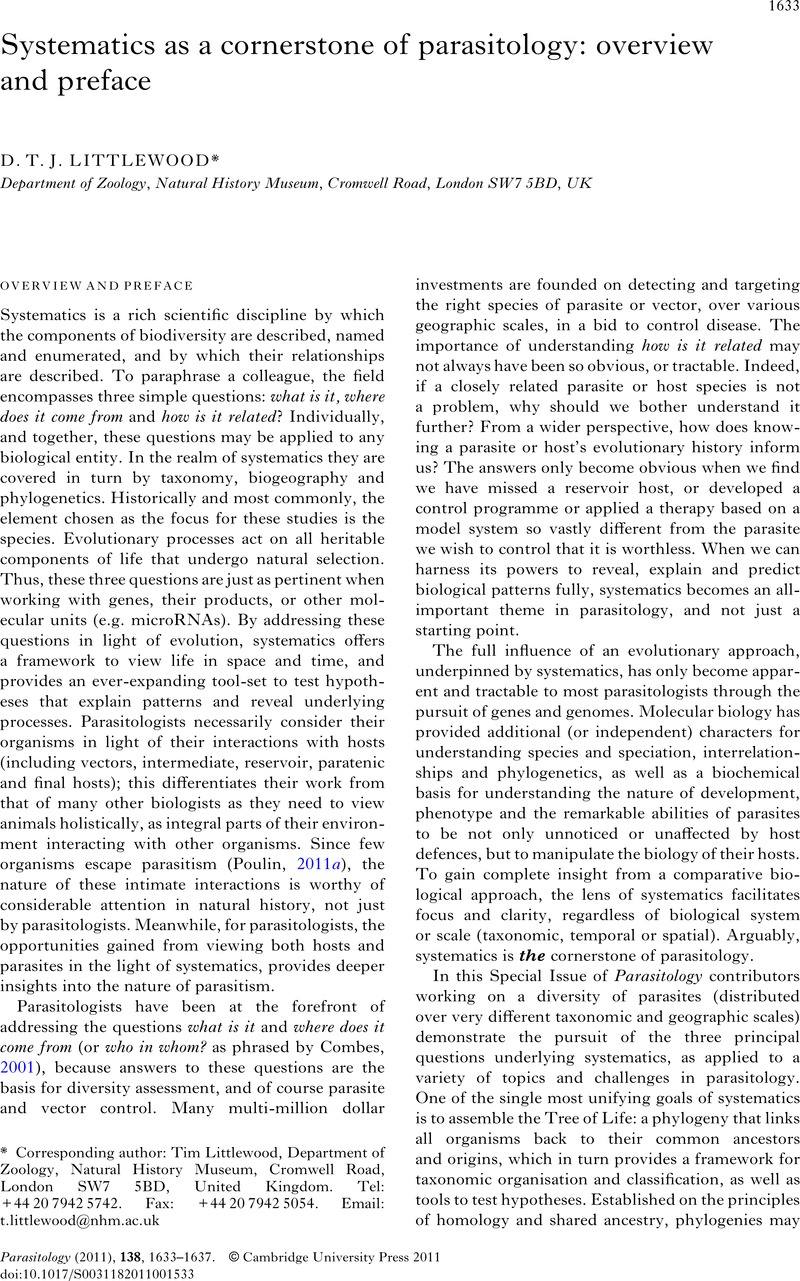Crossref Citations
This article has been cited by the following publications. This list is generated based on data provided by Crossref.
Poddubnaya, Larisa G.
Xylander, Willi E. R.
and
Gibson, David I.
2012.
Ultrastructural characteristics of the protonephridial terminal organ and associated ducts of adult specimens of the Aspidogastrea, Digenea and Monogenea, with comments on the relationships between these groups.
Systematic Parasitology,
Vol. 82,
Issue. 2,
p.
89.
Jorge, Fátima
Perera, Ana
Carretero, Miguel A.
James Harris, D.
and
Roca, Vicente
2013.
Cryptic species unveiled: the case of the nematode Spauligodon atlanticus
.
Journal of Zoological Systematics and Evolutionary Research,
Vol. 51,
Issue. 3,
p.
187.
OUTLAW, DIANA C.
and
RICKLEFS, ROBERT E.
2014.
Species limits in avian malaria parasites (Haemosporida): how to move forward in the molecular era.
Parasitology,
Vol. 141,
Issue. 10,
p.
1223.
Vanhove, Maarten P. M.
Economou, Alcibiades N.
Zogaris, Stamatis
Giakoumi, Sofia
Zanella, Davor
Volckaert, Filip A. M.
and
Huyse, Tine
2014.
The Gyrodactylus (Monogenea, Gyrodactylidae) parasite fauna of freshwater sand gobies (Teleostei, Gobioidei) in their centre of endemism, with description of seven new species.
Parasitology Research,
Vol. 113,
Issue. 2,
p.
653.
De Baets, Kenneth
and
Littlewood, D. Timothy J.
2015.
Fossil Parasites.
Vol. 90,
Issue. ,
p.
1.
Vanhove, Maarten P. M.
and
Huyse, Tine
2015.
Parasite Diversity and Diversification.
p.
401.
Poulin, Robert
and
Presswell, Bronwen
2016.
Taxonomic Quality of Species Descriptions Varies over Time and with the Number of Authors, but Unevenly among Parasitic Taxa.
Systematic Biology,
Vol. 65,
Issue. 6,
p.
1107.
Martínez-Aquino, Andrés
Vidal-Martínez, Victor M.
and
Aguirre-Macedo, M. Leopoldina
2017.
A molecular phylogenetic appraisal of the acanthostominesAcanthostomumandTimoniellaand their position within Cryptogonimidae (Trematoda: Opisthorchioidea).
PeerJ,
Vol. 5,
Issue. ,
p.
e4158.
Bennett, Jerusha
Jorge, Fátima
Poulin, Robert
and
Randhawa, Haseeb
2019.
Revealing trophic transmission pathways of marine tapeworms.
Parasitology Research,
Oliveira, Luísa
Dias, Roberto Júnio Pedroso
Rossi, Mariana F.
D’Agosto, Marta
and
Santos, Huarrisson A.
2020.
Molecular diversity and coalescent species delimitation of avian haemosporidian parasites in an endemic bird species of South America.
Parasitology Research,
Vol. 119,
Issue. 12,
p.
4033.
Carlson, Colin J.
Dallas, Tad A.
Alexander, Laura W.
Phelan, Alexandra L.
and
Phillips, Anna J.
2020.
What would it take to describe the global diversity of parasites?.
Proceedings of the Royal Society B: Biological Sciences,
Vol. 287,
Issue. 1939,
p.
20201841.



